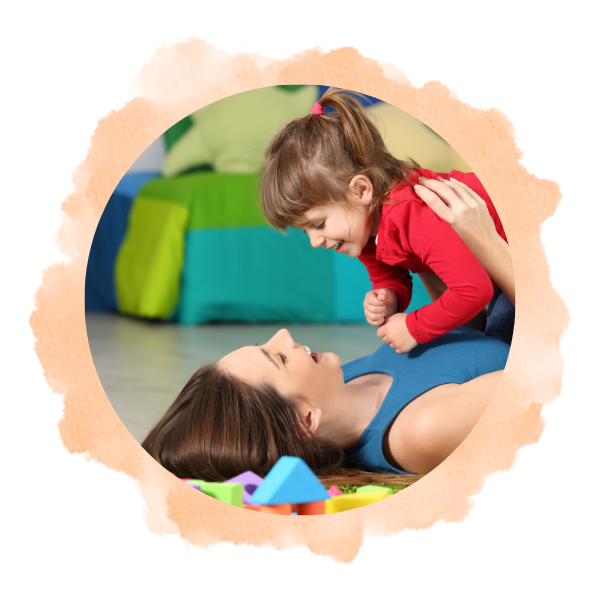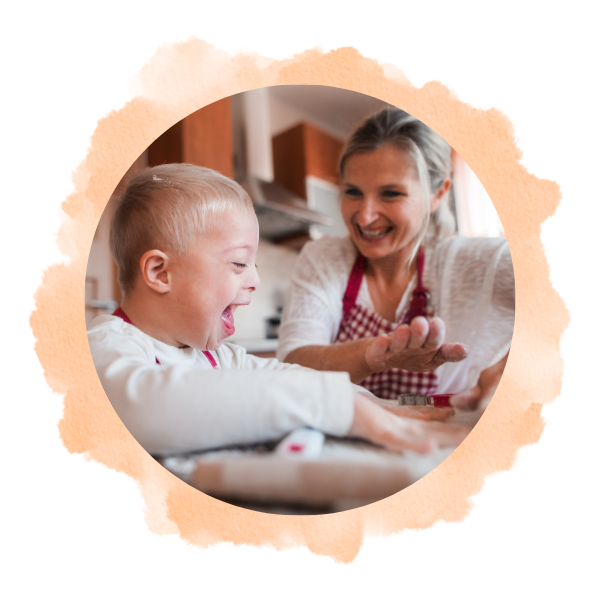“Have Fun!” – An Essential Ingredient for Children’s Language Learning
Have fun!
Why is this a key interaction goal for every child enrolled in It Takes Two to Talk® – The Hanen Program® for Parents of Children with Language Delays?

…because research shows that children learn to communicate within enjoyable (i.e., “fun”), extended interactions with their caregivers. So, having fun during interactions is an essential part of children’s language learning, which is why it’s a focus in all Hanen Programs for parents.
You might know “fun” when you see it, but fun can be hard to put into concrete terms. For this reason, it may feel challenging to coach parents to “make sure you’re having fun,” even if this suggestion has the potential to significantly improve their interactions with their child.
A closer look at having fun in relation to children’s language learning
Having fun is closely linked to learning. Children are more likely to acquire language that:
- relates to what interests them;
- relates to what they are curious about; and
- feels achievable based on their existing knowledge and skills.
For an interaction to be (and remain) fun for children, you will need to ensure three important components are working in tandem.

- Interests & Curiosity – The interaction should be based on the child’s interests and curiosity – that means the interaction should involve activities the child finds enjoyable.
- Parent Responsiveness – When parents are responsive to the child’s interests and to what they communicate (i.e., they respond quickly and positively), research shows that language learning is accelerated.
- Motivation – When a parent is responsive, the child feels competent and connected, which motivates them to stay in the interaction and use their communication skills.
What a child finds fun changes over time. As a child masters an interaction or language skill, this will naturally lead them to seek new ideas. Paying close attention to shifts in each child’s interests, curiosity, and motivation will keep the fun from tipping into boredom or frustration. For example, a game like Peek-a-Boo is initially fun, but children may tire of it when it becomes too predictable or loses its novelty.
Why is having fun important for parents?

Having fun improves the quality of parent-child interactions. When parents and children are both enjoying an interaction, the child’s language development benefits.
Parents are more responsive when they are enjoying an interaction with their child, which increases the quantity of back-and-forth communication. So, we can see that children stay in interactions longer when their parents are having fun.
6 Tips to Help Children and Parents Have Fun
TIP 1: Ask the parents about each child’s abilities, preferences, and goals
Understanding each child will help you to identify what they will find fun. During your assessment, be sure you have asked the parent about the child’s:
- Current communication skills
- Stage of play development and preferred type of play
- Interests and/or sensory preferences

TIP 2: Set communication goals collaboratively with the parents
Collaborate with parents to set appropriate goals for their child together. Choosing the right goals means setting expectations that are motivational because they are the next steps in the child’s abilities. Setting goals collaboratively also helps parents tune their own expectations in interactions to match their child’s next steps.
TIP 3: Choose the right activity
Guide parents to give the child an opportunity to choose a play activity they know their child enjoys. Remember, children who are on the autism spectrum may have sensory preferences that make one activity a better choice for encouraging communication than another.
Suggest to parents they avoid activities that distract from the potential for social interaction. Toys, games, and electronic books that “do all the work” with flashing lights, loud noises, or longer pre-recorded songs may make interaction more challenging.
TIP 4: Lay the foundation for a strong interaction - Observe, Wait and Listen (OWL™)
Fun breaks down when parents pursue an agenda that does not match their child’s interests.
- Have parents get Face to Face to make it easier for the child to communicate.
- Coach parents to Observe, Wait and Listen (OWL) so that they:
- Know what their child is interested in
- Understand their child’s favourite part of an activity
- Give their child a chance to take the first communicative turn
- Respond based on their child’s turn and interests
TIP 5: Follow the Child’s Lead

Once the interaction is started, Following the Child’s Lead can help parents to jumpstart the fun in an activity. Encourage parents to:
- Join In with what their child says and does in play. By playing like their child, parents show they share their child’s interests.
- Imitate what their child says and does in play. Children feel motivated to take another turn when their parents respond by copying their language and actions.
- Comment in response to what the child says or does. Using an exaggerated, fun voice can help the fun words stand out in a short, grammatical sentence.
TIP 6: Identify the child’s favourite part of the activity
Sometimes what a child is enjoying about an activity is different to what parents initially expect. Coaching parents to figure out their child’s favourite part of an activity will help them understand what their child finds fun about it. Identifying this “high point” means the parent will also provide the most motivating language for the child to hear and, in time, to use themself.
To Sum Up
Understanding what makes an interaction fun for a child helps you set parents up for success when they interact with their child. Coaching parents to have fun is easier when they are tuned in to what the child enjoys, and they know how to build on that, so the interactions keep going back and forth. This is when language learning takes off!
Hanen workshops provide you with training in how to facilitate child-parent interactions and keep the fun going. You can receive Hanen training even before you graduate. Learn more about the It Takes Two to Talk subsidy for students.
Similar articles by tag:
